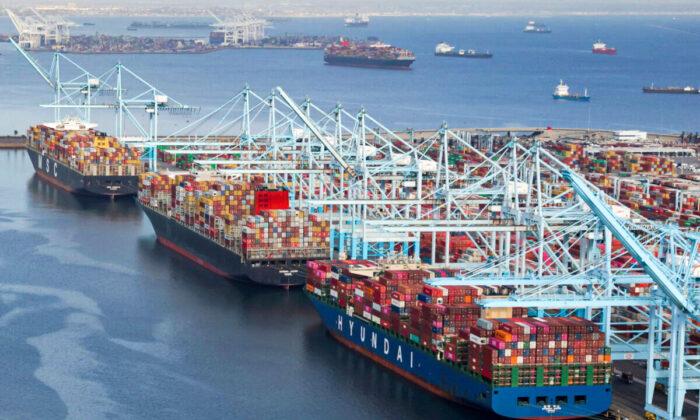“The sea carries more than 80 percent of the world’s traded goods, most of which sail inside 40-foot-long steel containers stacked by the thousands atop some of the largest vessels ever built,” said the IMF.
The current resurgence of inflation is expected to impact the global economy through the end of 2022, which “will create complicated trade-offs for many central bankers facing increasing inflation and still ample slack in economic activity,” said the international lender.
The shipping crisis had previously hit U.S.-Chinese trade routes the hardest, but this round of shortages is being acutely felt in Germany, which is heavily reliant on energy and other strategic commodities from Russia and Ukraine.
Ports from Shanghai to Los Angeles were shut down or faced severe backlogs, as the virus upended supply chains, underscoring the importance of the maritime container trade to the global economy.
Major port facilities were facing labor shortages, while trucker and ship crews couldn’t cross borders because of COVID-19 mandates and restrictions.
Cash from government stimulus programs raised demand during the lockdown period and overwhelmed the capacity of supply chains, causing massive delays in getting goods to customers and raising freight costs.
U.S. consumer inflation rose to a 40-year high of 7.9 percent over the past year, led by the increased cost of food, energy, and housing,
Expectations for growth in Germany during March posted the steepest one-month drop on record, as factories across Europe are facing diesel and parts shortages.
There are increasing delays moving cargo through key North Sea gateways, such as the port at Bremerhaven in Germany.
Rising shipping costs affect inflation in some countries more than others, hitting major net importing nations or those with poor infrastructure hard.
“Countries that import more of what they consume see larger increases in inflation, as do those who are more integrated into global supply chains,” said the IMF.
“Similarly, countries that typically pay higher freight costs—landlocked countries, low-income countries, and especially island states—see more inflation when these rise.”
The IMF said that data on shipping costs comes from its Baltic Dry Index (BDI) collected from 143 countries between 1992 and 2021.
The BDI was created by the London-based Baltic Exchange, which measures the average cost of transporting dry bulk materials across more than 20 shipping routes.
“Studying data from 143 countries over the past 30 years, we find that shipping costs are an important driver of inflation around the world: when freight rates double, inflation picks up by about 0.7 percentage point. Most importantly, the effects are quite persistent, peaking after a year and lasting up to 18 months,” said the IMF.
“This implies that the increase in shipping costs observed in 2021 could increase inflation by about 1.5 percentage points in 2022.”
The lender said that “pass-through to inflation effects” on shipping costs are much more volatile when compared to rises in food and fuel costs, and “as a result, the contribution in the variation of inflation due to global shipping price changes is quantitatively similar to the variation generated by shocks to global oil and food prices.”
The IMF said that rising shipping costs normally hit the price of imported goods within two months, with a quick knock-on effect felt on producer prices, many of whom rely on imported inputs to manufacture their goods.
The fund said that a “strong and credible monetary policy framework can play a role in mitigating the second-round effects from import prices and inflation.”
“Our analysis shows that keeping inflation expectations well-anchored is key to containing the effect of soaring shipping costs on consumer prices, particularly core measures that exclude fuel and food.”
The spot rate to send a 40-foot container of goods to the United States from Asia had averaged more than $10,000 in the second half of last year, about seven times higher than the pre-pandemic level.
Although U.S.-Asia shipping rates have come down in recent weeks after a seasonal dip, experts believe that transport costs will pick up again, as demand increases amid China’s struggle against a revival of the CCP virus.
Chinese exports were already declining from an October 2021 peak, a trend that might continue for the next few months if the CCP maintains its hard line on fighting the virus and another series of targeted lockdowns.
The U.S. Federal Reserve and the Bank of England both raised rates this month and have signaled that additional interest hikes are expected to come this year as the two central banks aim to tackle inflation.
The IMF said that its analysis predates the war in Ukraine, but said that it is not isolated from it, saying “the conflict will likely exacerbate global inflation,” especially if the conflict continues.





